This article concerns systems of transport in Lesotho. As a landlocked country, Lesotho has no seaports or harbours, but does have road, air transport, and limited rail infrastructure.
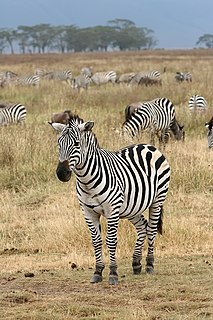
Zebras are African equines with distinctive black-and-white striped coats. There are three living species: the Grévy's zebra, plains zebra, and the mountain zebra. Zebras share the genus Equus with horses and asses, the three groups being the only living members of the family Equidae. Zebra stripes come in different patterns, unique to each individual. Several theories have been proposed for the function of these stripes, with most evidence supporting them as a deterrent for biting flies. Zebras inhabit eastern and southern Africa and can be found in a variety of habitats such as savannahs, grasslands, woodlands, shrublands, and mountainous areas.
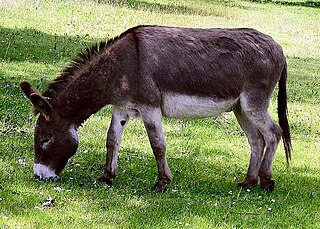
The domestic donkey is a hoofed mammal in the family Equidae, the same family as the horse. It derives from the African wild ass, Equus africanus, and may be classified either as a subspecies thereof, Equus africanus asinus, or as a separate species, Equus asinus. It was domesticated in Africa, probably about 5,000 or 6,000 years ago, and has been used mainly as a working animal since that time.

Tijuana, commonly known by its initials T.J., is a city and municipal seat of Tijuana Municipality, Baja California, located on the Pacific Coast of Mexico. It is part of the San Diego-Tijuana metro area and the larger Southern California megapolitan area. Tijuana is the second most populous city in Mexico and center of the 6th-largest metro area in Mexico, The city is one of the fastest-growing metro areas in the country and rated as a "High Sufficiency" global city by the Globalization and World Cities Research Network. As of September 2019, the city of Tijuana had a population of 1,810,645, with its metropolitan area containing a population of 2,157,853 as of 2020, an estimated 2,002,000 within the urban area.

A zebra crossing or a marked crosswalk is a pedestrian crossing marked with white stripes. Normally, pedestrians are afforded precedence over vehicular traffic, although the significance of the markings may vary by jurisdiction. They are known as "zebra" crossings as the stripes resemble the coat of a zebra.

A zebroid is the offspring of any cross between a zebra and any other equine to create a hybrid. In most cases, the sire is a zebra stallion. Offspring of a donkey sire and zebra dam are called a donkra and offspring of a horse sire and a zebra dam called a hebra do exist, but are rare and are usually sterile. Zebroids have been bred since the 19th century. Charles Darwin noted several zebra hybrids in his works.

The Kumeyaay, also known as Tipai-Ipai or by their historical Spanish name Diegueño, is a tribe of Indigenous peoples of the Americas who live at the northern border of Baja California in Mexico and the southern border of California in the United States. Their Kumeyaay language belongs to the Yuman–Cochimí language family.
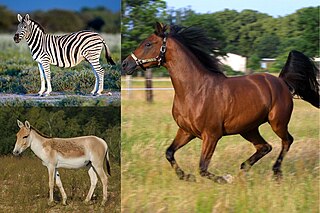
Equus is a genus of mammals in the family Equidae, which includes horses, donkeys, and zebras. Within the Equidae, Equus is the only recognized extant genus, comprising seven living species. Like Equidae more broadly, Equus has numerous extinct species known only from fossils. The genus most likely originated in North America and spread quickly to the Old World. Equines are odd-toed ungulates with slender legs, long heads, relatively long necks, manes, and long tails. All species are herbivorous, and mostly grazers, with simpler digestive systems than ruminants but able to subsist on lower-quality vegetation.

Custer State Park is a South Dakota State Park and wildlife reserve in the Black Hills, United States. The park is South Dakota's largest and first state park, named after Lt. Colonel George Armstrong Custer. The park covers an area of over 71,000 acres (287 km2) of varied terrain including rolling prairie grasslands and rugged mountains.

A bullock cart or ox cart is a two-wheeled or four-wheeled vehicle pulled by oxen. It is a means of transportation used since ancient times in many parts of the world. They are still used today where modern vehicles are too expensive or the infrastructure favor them.
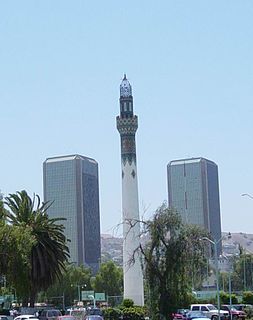
The Agua Caliente Casino and Hotel is a now-defunct resort that operated from 1928 to 1935. Although the casino and hotel were closed, the racetrack continued to operate for many years. The original grandstand structure was destroyed by fire in 1971, but was rebuilt and continues to operate today as the Agua Caliente Racetrack and Casino, a branch of the Casino Caliente chain.

Avenida Revolución is the tourist center in Tijuana, Baja California, México. It is a main thoroughfare of the historic downtown of Tijuana, officially called the Zona Centro, which forms part of the Delegación Centro or Central Borough of Tijuana.
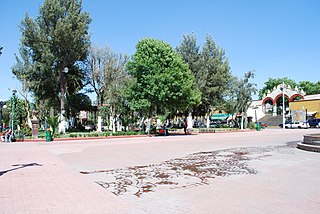
Otumba or Otumba de Gómez Farías is a town and municipal seat of the municipality of Otumba located in the northeast of the State of Mexico, just northeast of Mexico City. Historically, this area is best known as the site of the Battle of Otumba and as an important crossroads during the colonial period where incoming viceroys ceremoniously were handed power by their predecessors. Today, it is a rural municipality undergoing changes as urbanization arrives here from the Mexico City area. However, one element from the past that is still remembered is that of burros or donkeys. During the colonial period, Otumba was an important market for the animals, and they are still culturally important. Each year, the municipality sponsors a Feria de Burros or Donkey Fair, where the animals star in fashion shows, costume contests, and races. There is also a donkey sanctuary for unwanted animals.

Primitive markings are a group of hair coat markings and qualities seen in several equine species, including horses, donkeys, and asses. In horses, they are associated with primitive breeds, though not limited to such breeds. The markings are particularly associated with the dun coat color family. All dun horses possess at least the dorsal stripe, but the presence of the other primitive markings varies. Other common markings may include horizontal striping on the legs, transverse striping across the shoulders, and lighter guard hairs along the edges of a dark mane and tail.

Big Bend Ranch State Park is a 311,000-acre (126,000 ha) state park located on the Rio Grande in Brewster and Presidio counties, Texas. It is the largest state park in Texas. The closest major town is Presidio, Texas, where the state park's head office is located. It includes Colorado Canyon.
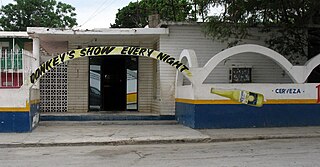
A donkey show is a type of live sex show in which a woman engages in bestiality with a donkey, which, according to urban legend and some works of fiction, were once performed in the Mexican border city of Tijuana, particularly in the mid-20th century.

The Tijuana Zonkeys are a Mexican professional basketball team based in Tijuana, Baja California. The Zonkeys are part of the Circuito de Baloncesto de la Costa del Pacífico (CIBACOPA). They play their home games at the Auditorio Academia Zonkeys. The team was founded in 2010, and won back-to-back championships in 2014 and 2015.

The Miranda donkey, Portuguese: Burro de Miranda, is an autochthonous donkey breed from the Terra de Miranda region of northeast Portugal.
Equid hybrids, also called hybrid equines, are created from the crossing of members from the horse family such as a horse, donkey and zebra.

















